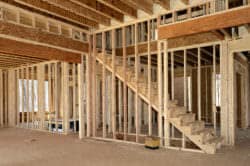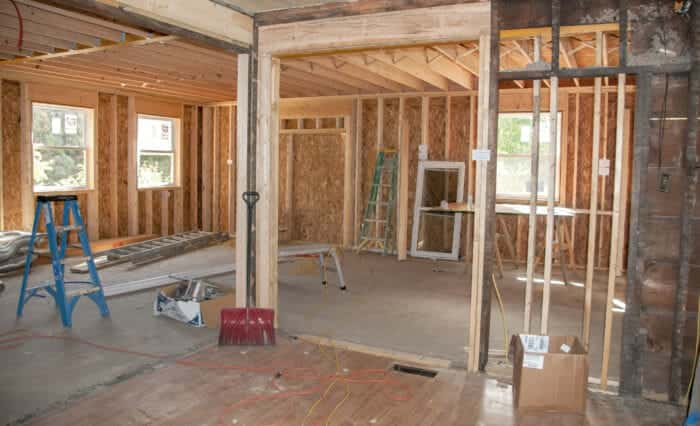How To Support A Load Bearing Wall For Repair

Removing a load begetting wall may create structural issues in a domicile, including sagging ceilings, unleveled floors, drywall cracks, and sticking doors. Recognizing the warning signs of this is of import. Even removing only a portion of a load bearing wall to create a wider door or window opening can be a problem if not done correctly.
Removal of load bearing walls without properly supporting the load they're carrying may occasionally result in a structural collapse and even injury.
What is a load bearing wall?
A abode has two basic types of walls, load bearing and not-load begetting. Just as the name implies, one carries weight higher up it and the other does non. A load bearing wall is a structural wall that may carry the weight of the roof, the weight of upper floors, and fifty-fifty the weight of a room'south ceiling. The weight is often referred to equally the "load".
The load, starting with the roof and everything under the roof gets transferred down to the footings. Engineers will oftentimes refer to the "load path", which is basically the way or road that the weight gets transferred down to the dwelling house'southward foundation and/or piers.
Generally, the outside walls are load bearing. The interior walls of a domicile may or may not be load bearing, depending on how the house was engineered. In older homes with a hallway down the center, one or both of the hallway walls may be load bearing. In many newer one-story homes that are built with trusses, there may not exist any interior load bearing walls because all of the loads get transferred to the exterior walls by the trusses.
Remodeling

The most likely time that a load begetting wall gets removed is when a home has remodeling work washed. Owners of older homes often want to have a more open floor plan, so they remove walls to go a more than open look. In the procedure, they remove a load begetting wall and don't realize that it is a load bearing wall. Professional contractors volition unremarkably check first to come across if a wall is load begetting before they remove information technology. If information technology is, they will normally put a header (forest or steel) in the opening to carry the weight. At times an engineer may have to exercise calculations on the design and header size.
Alert signs that a load bearing wall has been removed
Ceiling sagging or dropped down
If a wall is removed between two rooms or even moved to overstate a room, and then the ceiling may sag. This happens when proper structural support was non installed to carry the weight that the removed wall was holding. Drywall and plaster ceilings are generally connected to wooden ceiling joists spaced at 12, 16 or 24 inches on center or connected to wooden trusses. When a wall is removed that holds up the ends of the ceiling joists or the trusses, and then the weight of the ceiling and whatever load to a higher place it may cause the ceiling to sag or drop down. The ceiling may sag a half-inch or more, and in a few instances may collapse.
A 1/4 inch sag or a two-inch sag?
Ceilings that sag a quarter or even a half of an inch are not always a sign that a load bearing wall has been removed, since over fourth dimension ceilings may sag naturally. If a ceiling drops a half-inch right afterwards a load bearing wall has been removed, then that is a concern. A ceiling that sags an inch or two becomes more of concern that a load begetting wall has been removed and that the ceiling has not been properly supported. Consulting with a structural engineer can provide valuable information.
Floor sagging or not level
If a ii or three-story home has a load bearing wall removed without providing proper structural support, then the 2d or third story floor may sag in the area above where the load begetting wall under the floor was removed. If you see the flooring on the second or third story sags, then you should get down 1 story and expect at the ceiling area for sags or bows.
Doors and windows rubbing or sticking
If a load begetting wall has been removed on the beginning floor without proper support installed for the load above it; then the doors or windows on the floor above it may rub, stick, or not open because of the framing in the wall that the door or window is in may have shifted.
Remember that there are a number of reasons that doors or windows may stick or rub other than a load bearing wall existence removed. These reasons may include the shifting or movement of the foundation, swelling due to humidity and moisture, besides many coats of paint, or fifty-fifty poor workmanship and installation.
Cracks in the drywall or plaster
Information technology is common for cracks to appear in the drywall or plaster when a load bearing wall is removed without properly supporting the load that it was conveying. This is basically considering the ceiling area may drop or sag, resulting in cracks. Cracks may likewise occur in some of the wall areas due to the stress generated by the move of the framing, ceilings, and walls.
Note: Warning signs that a load bearing wall has been removed and no proper support has been installed, may non show up immediately after the piece of work is done. It may take months or even years for the warning signs of issues to show.
Removing a load bearing wall

When a load bearing wall is removed, or fifty-fifty a portion of information technology, there should be a programme on how the weight that it is carrying will be supported. The removal of a load bearing wall should be washed past a professional who understands how the weight that it is carrying will be temporarily supported while the permanent support modifications are existence installed. If the surface area being removed is small and the load is not excessive there may non demand to be support or just minimal support may be needed.
Typically a beam, either forest or metallic, will be installed in the area where the wall was removed to acquit the weight. At times a contractor may refer to this axle every bit a "header".
At each finish of the header or axle, a contractor will usually have a support of some type, ofttimes a post. The base of this mail needs a solid surface area or base to sit on. At times a physical pier or basis is required to be installed to facilitate carrying the weight.
Engineers have different ways to support a ceiling where a load begetting wall has been removed
Homeowners and buyers usually have several choices on how to support the load above a load begetting wall once removed. Naturally, some means are more than complex or costly than others. Knowledgeable and appropriately qualified general contractors and framing contractors are adept resources to consult with equally well as structural engineers.
Permits
Generally, nearly Building Jurisdictions require a permit when there are structural modifications to a house. Small-scale openings for doors and windows are typically quick and easy to obtain. When a long or big load bearing wall is going to be removed, and so the building departments will usually require a set of plans that are stamped past a structural engineer. If at that place is any electrical or plumbing in the wall, and then an electrical and plumbing permit may be required for those modifications.

- Yous may merely need preventive maintenance
- If very minor, and then mayhap y'all just demand to monitor information technology
- If repair is needed, it is much cheaper to correct in the early stages than after it has become a big trouble
- Should it be major, and then you may need to consult a qualified professional
Accept a minute and review our other articles to run across if you lot accept any warning signs of potential problems.
Manufactures and Resource On Mutual Structural Issues In Homes
In some of our articles we provide links to products that may be beneficial given the subject affair of the content. Nosotros receive a minor committee if y'all choose to buy a product or service after following 1 of our affiliate links just the price is the same for you.
Source: https://buyersask.com/structural/load-bearing-walls/
Posted by: norrisaffeas.blogspot.com



0 Response to "How To Support A Load Bearing Wall For Repair"
Post a Comment